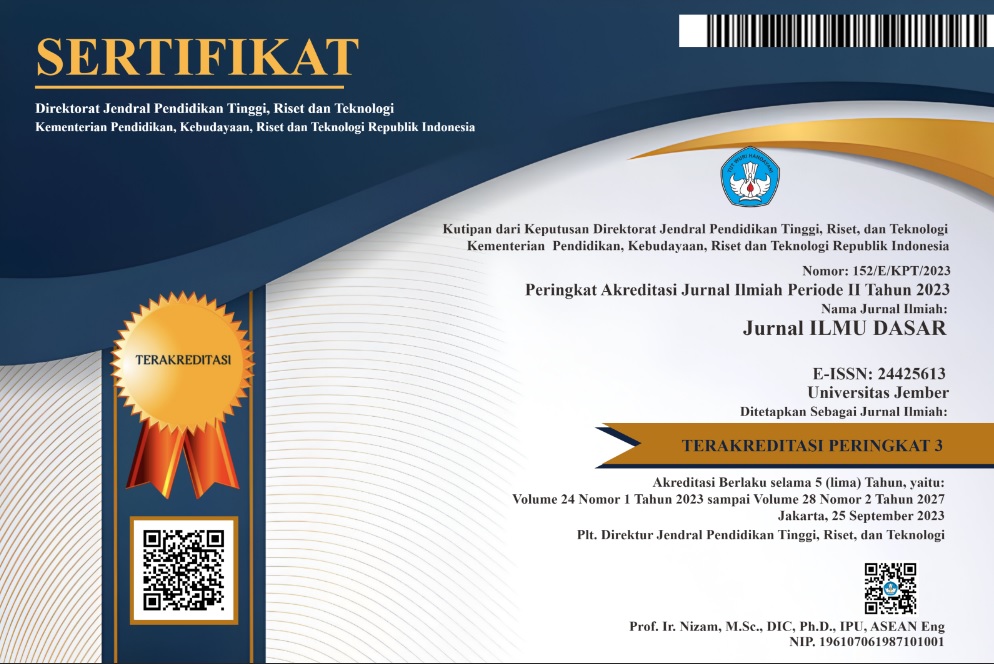Cardioprotective Effect of Chloroform Extract of Arcangelisia flava on Doxorubicin-induced Cardiomyopathy
DOI:
https://doi.org/10.19184/jid.v23i1.23012Keywords:
chloroform extract of Arcangelisia flava, doxorubicin-treated rat, cardio protective, phytochemical screeningAbstract
Long-term use of doxorubicin as cancer chemotherapeutic agent would cause tissue toxicity, including cardiotoxicity. Arcangelisia flava is suggested to have cardio protective effect. This study aimed to determine the effect of chloroform extract of A. flava leaves on cardio histopathology of doxorubicin-treated Wistar white male rats. Wistar male rats were divided into four groups (1) control group; (2) doxorubicin 7.5 mg/kgBW intraperitoneally twice (day 1 and 6); (3) doxorubicin + chloroform extract of A. flava leaves 250 mg/kgBW/day orally for 11 days; (4) Chloroform extract of A. flava leaves 250 mg/kgBW/day orallly for 11 days. At the 12th day, the rats were sacrificed; the heart organ was taken to make histopathological preparations and analyzed using HE staining. Vacuolization and necrosis are the parameters used in evaluating this effect. The phytochemical screening was also done to determine the compounds in chloroform extract of A. flava leaves. Based on the HE staining, chloroform extract of A. flava leaves decreased the cardiotoxicity caused by doxorubicin. The phytochemical screening showed that chloroform extract of A. flava leaves contains flavonoid, tannin, alkaloid, and triterpenoid. The cardioprotective effect of chloroform extract of A. flava leaves was suggested to be contributed by the flavonoid, tannin, and triterpenoid.
Downloads
References
Billingham, ME, Mason JW, Bristow MR & Daniels JR. 1978. Anthracycline Cardiomyopathy Monitored by Morphologic Changes. Cancer Treatment Reports. 62(6): 865-872.
Brundtland GH. 2003. Global Cancer Rates Could Increase by 50% to 15 Million by 2020. http://www.who.int
Fong and Tse-Ling. 2002. Hepatocellular Carcinoma (Liver Cancer). http://www.medicinet.com
Frias MAU, Lang U, Gerber-Wicht C & James RW. 2010. Native and Reconstituted HDL Protect Cardiomyocytes from Doxorubicin-induced Apoptosis. Cardiovascular Research. 85(1): 118-126.
Keawpradub N, Dej-Adisai S & Yuenyongsawad S. 2004. Antioxidant and Cytotoxic Activities of Thai Medicinal Plants Named Khaminkhruea: Songklanakarin. J. Sci. Technol. 27:456-466.
Mamta K & Sashi J. 2012. Tannins: an Antinutrient with Positive Effect to Manage Diabetes. Research Journal of Recent Sciences. 1(12): 1-8.
Maryani M, Nursyam H & Maftuch. 2013. The Phytochemistry and The Anti-bacterial Activity of Yellow Root (Arcangelisia flava Merr.) against Aeromonas hydrophila. Journal of Biology and Life Science. 4:180-190.
Mira L, Fernandez MT, Santos M, Rocha R, Florêncio MH & Jennings KR. 2002. Interactions of Flavonoids with Iron and Copper Ions: a Mechanism for Their Antioxidant Activity. Free Radical Research. 36(11): 1199-1208.
Oliboni LS, Dani C, Funchal C, Henriques JA & Salvador M. 2011. Hepatoprotective, Cardioprotective, and Renal-protective Effects of Organic and Conventional Grapevine Leaf Extracts (Vitis labrusca var. bordo) on Wistar Rat
Tissues. Anais Da Academia Brasileira de Ciencias. 83(4): 1403-1411.
Panchal SK & Brown L. 2013. Cardioprotective and Hepatoprotective Effects of Ellagitannins from European Oak Bark (Quercus petraea L.) Extract in Rats. European Journal of Nutrition. 52(1): 397-408.
Pascual ME, Carretero ME, Slowing KV & Villar A. 2002. Simplified Screening by TLC of Plant Drugs. Pharmaceutical Biology. 40(2): 139-143.
Pontes JCDV, Gomez JF, Da Silva GVR, Benfatti RA, Dias AEMSÃS, Duarte, N. Gardena JJ, Odashiro M & Dos Santos CHM. 2010. Anatomopathological Study of Cardiomyopathy Induced by Doxorubicin in Rats. Acta Cirurgica Brasileira. 25(2): 137-143.
Raksamiharja R, Sy K, Zulharini MS, Novarina A & Sasmito E. 2012. Elettaria cardamomum Distillate Increases Cellular Immunity in Doxorubicin Treated Rats. Indonesian Journal of Cancer Chemoprevention. 3(3): 437.
Robinson T. 1995. Kandungan Organik Tumbuhan Tinggi. Bandung: Institut Teknologi Bandung.
Scalbert A, Manach C, Morand C, Rémésy C, & Jiménez L. 2005. Dietary Polyphenols and The Prevention of Diseases. Critical Reviews in Food Science and Nutrition. 45(4): 287-306.
Shanmugarajan TS, Arunsundar M, Somasundaram I, Krishnakumar E, Sivaraman D & Ravichandrian V. 2008. Cardioprotective Effect of Ficus hispida Linn. on Cyclophosphamide Provoked Oxidative Myocardial Injury in a Rat Model. International Journal of Pharmacology. 4: 78-87.
Takemura G & Fujiwara H. 2007. Doxorubicin-induced Cardiomyopathy from The Cardiotoxic Mechanisms to Management. Progress in Cardiovascular Diseases. 49(5): 330-352.
van Acker FA, Hulshof JW, Haenen GR, Menge WM, van der Vijgh WJ & Bast A. 2001. New Synthetic Flavonoids as Potent Protectors Against Doxorubicin-Induced Cardiotoxicity. Free Radical Biology & Medicine. 31(1): 31-37.
Wagner H & Grevel J. 1982. Cardiotonic Amines from Crataegus oxyacantha. Planta Med. 45: 99-101.








